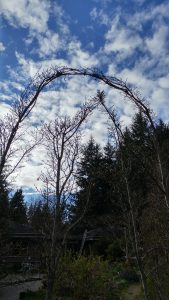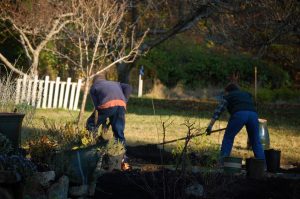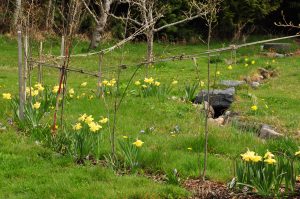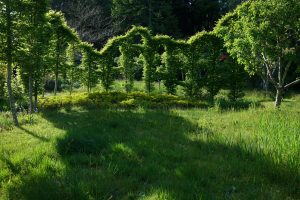
Today’s blog post is courtesy of Mary Blockberger of Sechelt, BC. As you’ll see, Mary and I go way back. I thought it was important to our ongoing discussion to see how the industry can use the root-washing technique effectively and economically. Here’s Mary:
“Before I began managing the Sunshine Coast Botanical Garden in Sechelt, BC I had a small residential landscaping company. By small, I mean that I was the employee of the month every month of the year! One of our Garden’s mandates is to provide relevant and educational programs for our community. Dr. Linda Chalker-Scott has been one of our most popular speakers several times. One of her presentations dealt with the practise of bare-rooting perennials, shrubs, and trees prior to planting, and the tremendous advantages of following this method.

“In November, 2007 I had a chance to try this technique out. My client wanted a ribbon of Carpinus betulus ‘Fastigiata’ planted that would eventually be pleached into an interesting pattern. [Pleaching is a formal tree training technique.] There was a total of 36 trees to be planted; most were container stock as I recall but there may have included a couple of B&Bs as well. Working with another local landscaper, into a wheelbarrow of water went every single tree one at a time. The dirt was clawed away from the root balls by hand with a final spray from the hose. Honestly, it was a cold and miserable job, and I believe a few curses directed at Linda ensued. However, once the roots were cleaned of all soil planting was a breeze. It’s a lot easier moving trees without moving the soil too.

“Flash forward 12 years, and every single tree has flourished. Bare rooting allowed us to identify and correct any problems before planting, and I’m sure this has a lot to do with the trees’ success. It’s a time consuming and at times messy method, but the reward of a healthy row of trees is well worth the effort, IMHO.”

And let me add to Mary’s account that a ZERO replacement rate is going to pencil out to long term economic success. I was able to see these trees earlier this year – that’s my photo at the top of this post.
Over the past 10 years, my wife & I increasingly adopted root-washing as standard practice for trees added to our landscape, perhaps a couple dozen all told. It was eye-opening how much the condition of the root ball varied among these specimens, whereas the planting instructions that came with them were of one voice: dig a hole, do not remove the wire basket, do not remove the soil, even when half of the pot contents consisted of a clay cap. Once that not-so-essential soil was removed, some trees required major & traumatic surgery, whereas others were plunked straight into their planting holes. We had begun our tree planting several years before that, and occasionally still remove a poorly performing individual. Without exception, their roots had marginally crept from the original pot-bound root ball (most recently, a lacebark pine), or had suffered self-strangulation from encircling roots (the latest, a Gambel oak). These were expensive lessons to learn, and why the cognitive dissonance between root condition and planting instructions persists is beyond my comprehension.